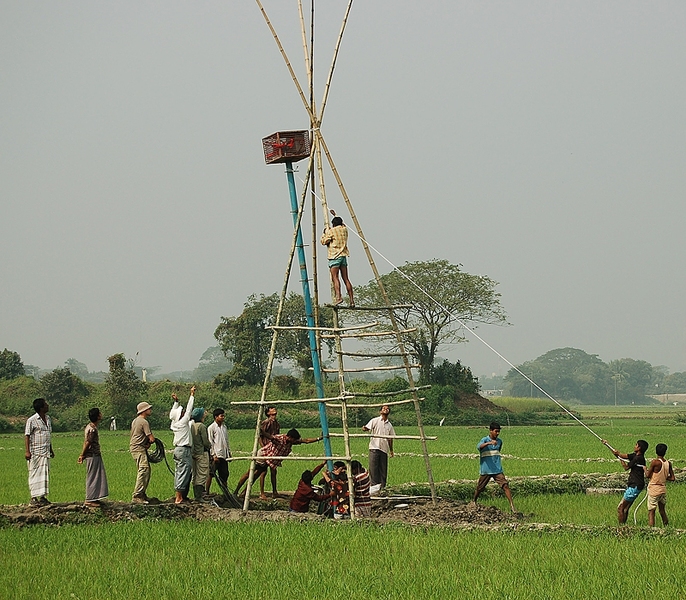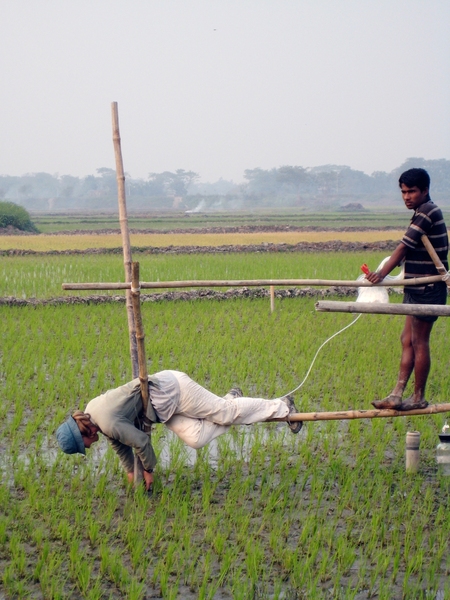Researchers in MIT’s Department of Civil and Environmental Engineering believe they have pinpointed a pathway by which arsenic may be contaminating the drinking water in Bangladesh, a phenomenon that has puzzled scientists, world health agencies and the Bangladeshi government for nearly 30 years. The research suggests that human alteration to the landscape, the construction of villages with ponds, and the adoption of irrigated agriculture are responsible for the current pattern of arsenic concentration underground. The findings also indicate that drinking-water wells drilled to a greater depth would likely provide clean water.
Bangladesh is the seventh most populous country in the world, and tens of millions of its citizens have been exposed to arsenic in their water over the past several decades. As many as 3,000 Bangladeshis die from arsenic-induced cancer each year and today approximately 2 million people in the country live with arsenic poisoning, which manifests as skin lesions and neurological disorders, and causes cardiovascular and pulmonary diseases and cancer. Allan H. Smith a professor of epidemiology at the University of California, Berkeley, calls it “the largest mass poisoning of a population in history.”
This pervasive incidence of arsenic poisoning and its link to drinking water were first identified in the early 1980s. This was not long after the population began switching from surface water sources like rivers to groundwater from tube wells — part of a national effort to decrease the incidence of bacterial illnesses caused by contaminated drinking water. But most of the tube wells have been drilled to less than 100 feet, where they draw water directly from the arsenic-contaminated shallow aquifer. Scientists have struggled to understand how the arsenic, which is naturally occurring in the underground sediment of the Ganges Delta, is getting into the groundwater.
By 2002, a research team led by Charles Harvey, the Doherty Associate Professor of Civil and Environmental Engineering at MIT, had determined that microbial metabolism of organic carbon was mobilizing the arsenic off the soils and sediments, and that crop irrigation was almost certainly playing a role in the process. But the exact sources of the contaminated water have remained elusive, until now.
In a paper appearing online in Nature Geoscience Nov. 15, Harvey, former graduate students Rebecca Neumann and Khandaker Ashfaque and co-authors explain that ponds are the source of the organic carbon that presently mobilizes the arsenic in their 6-square-mile test site. The carbon settles to the bottom of the ponds, then seeps underground where microbes metabolize it. This creates the chemical conditions that cause arsenic to dissolve off the sediments and soils and into the groundwater.
“Our research shows that water from the ponds carries degradable organic carbon into the shallow aquifer. Groundwater flow, drawn by irrigation pumping, transports that pond water to the depth where dissolved arsenic concentrations are greatest and where it is then pumped up into the irrigation and drinking wells,” says Harvey, whose research was funded by the National Science Foundation and the Singapore-MIT Alliance for Research and Technology. “The other interesting thing we found in our test area is that the rice fields are a sink of arsenic — more arsenic goes in with the irrigation water than comes out in the groundwater.”
Scott Fendorf, a professor at Stanford University who studies arsenic content in soils and sediments along the Mekong River in Cambodia, says Harvey’s previous research, published in 2002, “transformed the scientific community’s outlook on the problem.” The current work, he adds, has two big ramifications: “It shows that human modifications are impacting the arsenic content in the groundwater; and that while the rice cropping system appears to be buffering the arsenic, the ponds excavated to provide fill to build up the villages are having a negative impact on the release of arsenic.”
Ashfaque and Neumann did extensive fieldwork in Bangladesh over a seven-year period, studying the hydrologic behavior and chemical nature of rice fields and ponds and developing an understanding of the surface and underground water flow patterns and creating a 3-D model to track rice field and pond water as it traveled into and through the subsurface.
“When we compared the chemical signatures of the different water sources in our study area to the signatures of the aquifer water, we saw that water with high arsenic content originates from the human-built ponds, and water with lower arsenic content originates from the rice fields,” says Neumann. “It’s likely that these same processes are occurring at other sites, and it suggests that the problem could be alleviated by digging deeper drinking water wells below the influence of the ponds or by locating shallow drinking wells under rice fields.” The researchers suggest that irrigation wells remain at the shallow level.
Harvey is making plans for a multi-year study that would provide deep wells— deeper than 450 feet — for two villages in Bangladesh whose inhabitants suffer from arsenic poisoning. There they would combine continual testing of the well water and hydrogeological modeling of the groundwater system with a study of how the clean water effects the villagers’ health, placing special emphasis on the neurological development of children.
“There are all sorts of studies to show how arsenic hurts people. We’re trying to turn it around and show how removal of the arsenic will help them,” says Harvey.
Bangladesh is the seventh most populous country in the world, and tens of millions of its citizens have been exposed to arsenic in their water over the past several decades. As many as 3,000 Bangladeshis die from arsenic-induced cancer each year and today approximately 2 million people in the country live with arsenic poisoning, which manifests as skin lesions and neurological disorders, and causes cardiovascular and pulmonary diseases and cancer. Allan H. Smith a professor of epidemiology at the University of California, Berkeley, calls it “the largest mass poisoning of a population in history.”
This pervasive incidence of arsenic poisoning and its link to drinking water were first identified in the early 1980s. This was not long after the population began switching from surface water sources like rivers to groundwater from tube wells — part of a national effort to decrease the incidence of bacterial illnesses caused by contaminated drinking water. But most of the tube wells have been drilled to less than 100 feet, where they draw water directly from the arsenic-contaminated shallow aquifer. Scientists have struggled to understand how the arsenic, which is naturally occurring in the underground sediment of the Ganges Delta, is getting into the groundwater.
By 2002, a research team led by Charles Harvey, the Doherty Associate Professor of Civil and Environmental Engineering at MIT, had determined that microbial metabolism of organic carbon was mobilizing the arsenic off the soils and sediments, and that crop irrigation was almost certainly playing a role in the process. But the exact sources of the contaminated water have remained elusive, until now.
In a paper appearing online in Nature Geoscience Nov. 15, Harvey, former graduate students Rebecca Neumann and Khandaker Ashfaque and co-authors explain that ponds are the source of the organic carbon that presently mobilizes the arsenic in their 6-square-mile test site. The carbon settles to the bottom of the ponds, then seeps underground where microbes metabolize it. This creates the chemical conditions that cause arsenic to dissolve off the sediments and soils and into the groundwater.
“Our research shows that water from the ponds carries degradable organic carbon into the shallow aquifer. Groundwater flow, drawn by irrigation pumping, transports that pond water to the depth where dissolved arsenic concentrations are greatest and where it is then pumped up into the irrigation and drinking wells,” says Harvey, whose research was funded by the National Science Foundation and the Singapore-MIT Alliance for Research and Technology. “The other interesting thing we found in our test area is that the rice fields are a sink of arsenic — more arsenic goes in with the irrigation water than comes out in the groundwater.”
Scott Fendorf, a professor at Stanford University who studies arsenic content in soils and sediments along the Mekong River in Cambodia, says Harvey’s previous research, published in 2002, “transformed the scientific community’s outlook on the problem.” The current work, he adds, has two big ramifications: “It shows that human modifications are impacting the arsenic content in the groundwater; and that while the rice cropping system appears to be buffering the arsenic, the ponds excavated to provide fill to build up the villages are having a negative impact on the release of arsenic.”
Ashfaque and Neumann did extensive fieldwork in Bangladesh over a seven-year period, studying the hydrologic behavior and chemical nature of rice fields and ponds and developing an understanding of the surface and underground water flow patterns and creating a 3-D model to track rice field and pond water as it traveled into and through the subsurface.
“When we compared the chemical signatures of the different water sources in our study area to the signatures of the aquifer water, we saw that water with high arsenic content originates from the human-built ponds, and water with lower arsenic content originates from the rice fields,” says Neumann. “It’s likely that these same processes are occurring at other sites, and it suggests that the problem could be alleviated by digging deeper drinking water wells below the influence of the ponds or by locating shallow drinking wells under rice fields.” The researchers suggest that irrigation wells remain at the shallow level.
Harvey is making plans for a multi-year study that would provide deep wells— deeper than 450 feet — for two villages in Bangladesh whose inhabitants suffer from arsenic poisoning. There they would combine continual testing of the well water and hydrogeological modeling of the groundwater system with a study of how the clean water effects the villagers’ health, placing special emphasis on the neurological development of children.
“There are all sorts of studies to show how arsenic hurts people. We’re trying to turn it around and show how removal of the arsenic will help them,” says Harvey.








